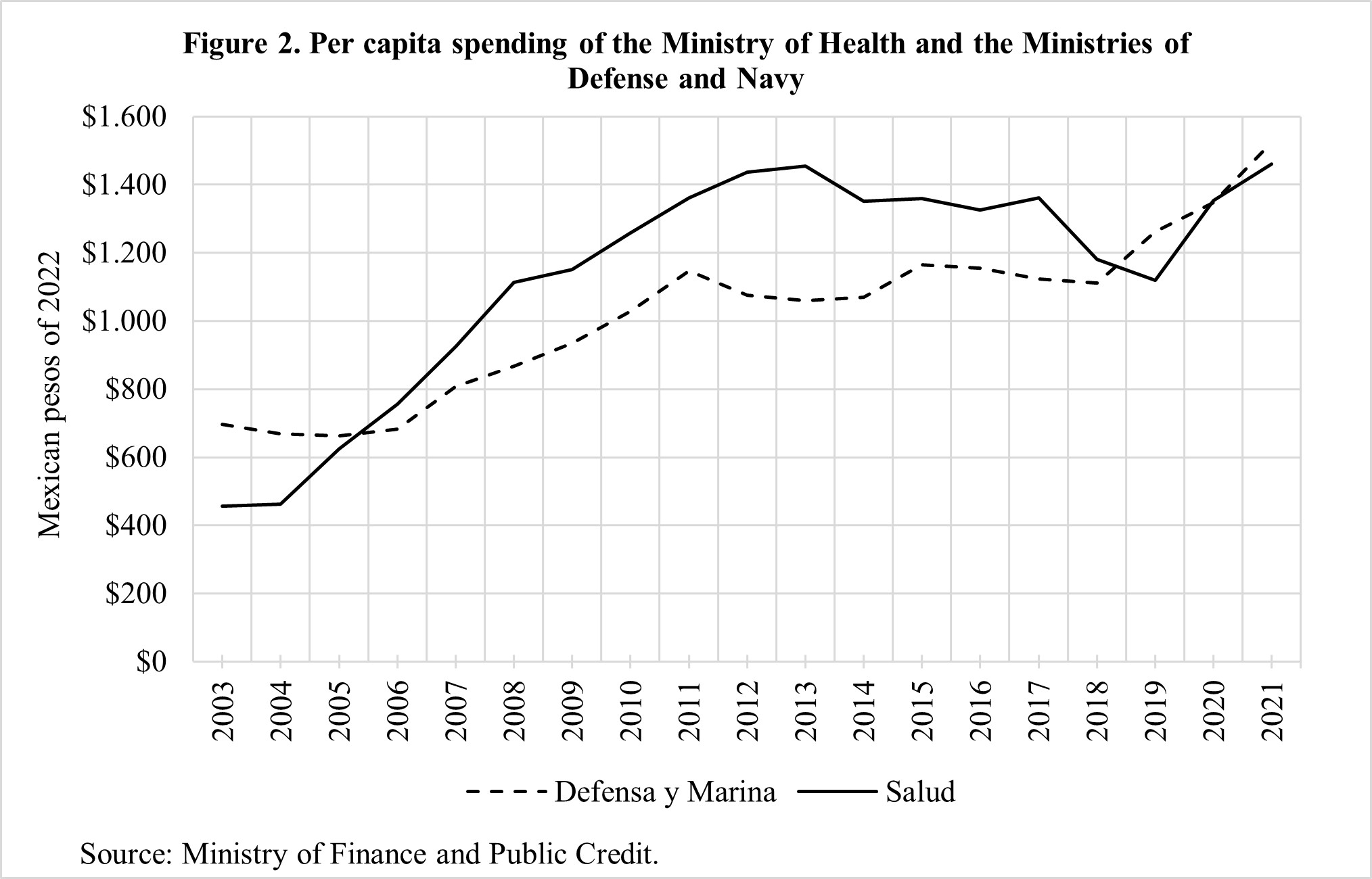Two years before the end of his term, Andrés Manuel López Obrador will leave heavily strengthened armed forces and a deep economic orthodoxy. Ramón I. Centeno (Universidad de Sonora) analyses the consequences of militarisation under AMLO’s presidency.
Lee este artículo en español
In a recent article for Politics, I suggested, along with two colleagues, the hypothesis that the six-year term of President Andrés Manuel López Obrador put Mexico in front of two scenarios: either a failed post-neoliberal transition or a weak transition.
Far from reversing the militarisation as he promised in campaign, AMLO has increased it. The budget and tasks of the armed forces have increased to levels never seen before. And regarding social policy, AMLO has acted more from the centre than from the left, so where should we place his military policy?
The civil-military equation
The revolution that Mexico lived during the 20th century led to a reconfiguration of the state apparatus, including the military. Built from the armed forces that won the civil war, the Army and its leaders soon became central to the post-revolution period. Mexico did not have a civilian president again until 1942.
Since then, a political consensus of civilian control of the military has prevailed. The democratisation underwent with the new century did not alter this consensus. Yet, the military power has gradually increased with the war on drugs launched in 2006 by then President Felipe Calderón.
In theory, the Mexican Army is aimed at tackling external threats, but in practice, it has always focused on internal security. During the Cold War, this was justified by the military on the grounds that any unrest had a foreign influence, specifically communism. The soldiers opening fire against students on October 2,1968, was only the best-known case of constant practice in both urban and rural scenarios throughout the country.
In contrast to that time, there is no excuse (neither real nor fictitious) for a threat of foreign origin today. Since 2006, the armed forces have been in a legal limbo after they took on tasks typical of the Federal Police – and that limbo only had two solutions: either return the Army to its barracks or legalise the Army’s presence on the streets. AMLO promised the first option but carried out the latter.
AMLO culminates Calderón’s work
Apart from being the president, AMLO is both the founder and leader of Mexico’s current dominant party, the Movement of National Regeneration (Morena). Since democratisation, there has not been a more powerful presidency. The last time a ruling party had a majority in the Parliament was in 1997, in the final gasps of authoritarianism. This is not just any majority. Between 2018 and 2021, AMLO and his party had the ability to reform the Constitution at their will, a scarce luxury among the Latin American progressive governments. By contrast, Gabriel Boric’s Chile has recently seen a long constitutional process that was ultimately defeated in a referendum. Mexico under AMLO required a simple and infrequent straight line: the will of the current ruling elite.
Certainly, López Obrador has indeed reformed the Constitution, but not to the left. Presence on the streets by the Army and Navy, performing internal security duties since the start of the so-called war on drugs in 2006, was a legal irregularity that AMLO settled. The Decree of Constitutional Reform n. 235, of March 2019, regularised militarisation for five years until 2024 but also created the National Guard in replacement of the Federal Police. This reform not only completed what Calderón started but actually exceeded him by putting the new armed force, the National Guard, under military command and subordinated to the Army. This, in contrast to what the Federal Police was, with a civilian command and subordinated to a civilian institution, the Ministry of Public Security.
This is the context in which the new AMLO’s unfolding constitutional reform makes sense. The current administration has increased the military presence on the streets from five to nine years (until 2028). Will it be extended again by the end of that deadline? We certainly know that the next presidency, which will be in office between 2024 and 2030, will remain constrained in this area by AMLO’s current decisions.
Austerity, but not for the Army
One of the pillars of AMLO’s administration has been the so-called republican austerity. Just like in the rest of the neoliberal world, Mexico also advocates for budgetary cuts. The innovation here is that this policy is framed as “leftist”.
However, and in contrast to the cuts in the rest of the public administration, the Army spending has grown at an average pace of 16% annually in the first three years of AMLO. In 2021 the spending of the Army was already 54% above that of 2018, the last year of Enrique Peña Nieto. Further than that, and as shown in Figure 1, AMLO has widened the gap between the actual spending of the Army and the budget originally allocated.
This has only occurred under Calderón, when his last three years in government (2010-2012) saw the Army’s annual spending exceed the original budget by an average of 19%. With López Obrador, the Army’s spending has exceeded the original budget by 20% on average, and this only in his first three years in office (2018-2021).
If Calderón assigned the armed forces public security tasks, AMLO has also added business tasks, with duties such as building the branches of his Welfare Banks or managing the country’s seaports and customs. The president has also assigned them with the building and management (and profit from) the Mayan Train (in Yucatán) and the Santa Lucía airport (in Mexico City). As a result, the spending of both the Army and Navy already surpassed the public Health budget, something that has not happened since 2005, as can be seen in Figure 2. In his first year in power, López Obrador reduced the Health budget and only raised it in the following years due to the Covid-19 pandemic, but still falling behind the military spending.

AMLO’s militarisation does not come from a change of ideas. It shall not be forgotten that in a 2006 private meeting with the USA Ambassador, AMLO promised “to give the military more power and authority in counter-narcotics operations”, at the explicit request of the White House. However, in public, he pledged the opposite. Who was the authentic one? The politician in the United Estates Embassy or the speaker in a political rally?
What left?
Without any reform, the armed forces have seen their finances and duties increase. Apart from the presidency, they are the only other element of the Mexican state that has grown stronger in this presidential term. This Army and its command hierarchy is the same that took part in the disappearance of 43 students in the Ayotzinapa rural school of teachers in 2013. It is the same Army that has refused to clarify that involvement, that has impeded the related inquiries, and which has been freed from 16 arrest warrants that had been released against military men connected to this case.
The recent leak of classified documents of the Army by a hacktivist group has underlined the personality of an institution that considers the parents of children with cancer and the feminist movements as a threat akin to the drug cartels. Instead of curbing the increasing military power, AMLO has accelerated it.
Two years before the end of this term, the scenario of a failed post-neoliberal transition not only crystallises but may even be an understatement. We are not just dealing with a leader that continues (if not deepens) the economic orthodoxy he criticises. We are witnessing a failed progressivism that has overtaken the right in terms of military policy. With this left, who needs the right?
Notes:
• The views expressed here are of the author rather than the Centre or the LSE
• This post is based on a dissertation submitted on August 10th 2022, for the LSE MSc in International Migration and Public Policy
• Please read our Comments Policy before commenting
• Banner image: The Guardia Nacional or National Guard, public security of Mexico / Luxbox (Shutterstock)
Read the full article here

















